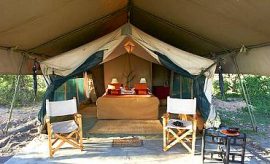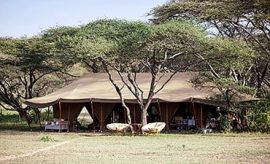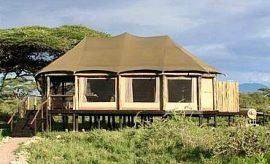
Symbiosis and commensalism
One of the famous natural phenomena is the annual migration of the huge herds of herbivores following the rains north through the Serengeti in the spring and back south in the fall. Wildebeest (keen smell and hearing, eat the shorter, fresh grass shoots) and zebras (excellent eyesight, eat the taller, coarser grass) have a symbiotic relationship and migrate together. The egrets have a commensal relationship with the herbivores, eating the insects stirred up from the grasses by them. Note the many newborn wildebeest in the photo.

Action at the Crossing!
Featured on Flickr Explore #45 on 20225-11-15.
The Great Migration is the largest herd movement of animals on the planet. In fact, with up to 1,000 animals per km², the great columns of wildebeest can be seen from space.
The numbers are astonishing: over 1.2 million wildebeest and 300,000 zebra along with topi and other gazelle move in a constant cycle through the Serengeti-Mara ecosystem in search of nutritious grass and water. Guided by survival instinct, each wildebeest will cover 800 to 1,000km on its individual journey along age-old migration routes. Hungry predators including lion, leopard, cheetah, hyena, wild dog and crocs make sure only the strongest survive in this natural spectacle also known as ‘the greatest show on Earth.’
The journey is beset with danger: young calves are snatched by predators, the slow are brought down by prides of lion, brave beasts break legs on steep river slopes, crocodiles take their share of the stragglers, and the weak and exhausted drown.
This amazing action packed scene was captured during recent photography safari on a late afternoon game drive in the Maasai Mara Game Reserve, Kenya.

A visit to Longleat
The Wildebeest
Scientific name: Connochaetes
Family: Bovidae (same as antelopes, cattle, and goats)
Common names: Wildebeest or gnu
Species:
Connochaetes taurinus – Common or blue wildebeest
Connochaetes gnou – Black wildebeest or white-tailed gnu
Despite their bovine build, wildebeests are technically antelopes—albeit with a design that looks like a committee couldn’t agree: sloping shoulders, spindly legs, a beard, and a boxy head with curved horns.
Habitat & Range
Found across eastern and southern Africa, especially in Tanzania, Kenya, Botswana, and South Africa
Thrive in grasslands, savannahs, and open woodlands
Often seen in wildlife reserves or managed conservation areas, like the Serengeti
This image likely shows a pair in a semi-natural enclosure—perhaps a reserve or zoo—where their social behavior and grazing patterns can still be observed.
Migration Marvel
The Great Migration involves over 1.5 million wildebeests, joined by zebras and gazelles, moving across the Serengeti and Maasai Mara in search of fresh grazing
Occurs annually, typically May–June, dictated by rainfall and grass growth
Considered one of the greatest wildlife spectacles on Earth
Their synchronized birthing season—500,000 calves born in February–March—ensures survival through sheer numbers.
Behavior & Adaptation
Highly social: Travel in large herds for protection
Day and night grazers: Constantly feeding on grasses
Calves walk within minutes: A vital adaptation for migratory life
Keystone species: Their grazing helps maintain grassland health and nutrient cycling
Conservation Notes
Threats: Habitat fragmentation, fencing, agriculture, and poaching
Status: Still abundant in many areas, but vulnerable to land-use changes
Conservation groups like AWF are working to protect their migratory corridors and habitats.

Blue Wildebeest Portrait (C. t. albojubatus) The Need to Scratch
Serengeti National Park
Tanzania
East Africa
The wildebeest, also called the gnu is an antelope in the genus Connochaetes native to Eastern and Southern Africa. It belongs to the family Bovidae, which includes antelopes, cattle, goats, sheep, and other even-toed horned ungulates. Connochaetes includes two species, both native to Africa: the black wildebeest or white-tailed gnu (C. gnou), and the blue wildebeest or brindled gnu (C. taurinus).
In East Africa, the blue wildebeest is the most abundant big-game species; some populations perform an annual migration to new grazing grounds, but the black wildebeest is merely nomadic. Breeding in both takes place over a short period of time at the end of the rainy season and the calves are soon active and are able to move with the herd, a fact necessary for their survival. Nevertheless, some fall prey to large carnivores, especially the spotted hyena.
Wildebeest often grazes in mixed herds with zebra, which gives heightened awareness of potential predators. They are also alert to the warning signals emitted by other animals such as baboons. Some illegal hunting goes on but the population trend is fairly stable, and some populations are in national parks or on private land. The International Union for Conservation of Nature lists both as least-concern species. - Wikipedia

2022.09.18.5365.iPhone Endless Serengeti, Endless Mara
Kenya's Masai Mara spreads out and recedes into Tanzania's Serengeti in an endless plain in East Arfica's Great Rift that comprises thousands of square miles and an annual migration of wildebeests, zebras and Thomson's gazelles. At this mid-September point in the migration cycle, millions of beasts still are clowly frazing their way north into the Mara Trangle. ©2022 John M. Hudson | jmhudson1.com

2022.09.18.1309.Z7II Great Migration
A herd of wildebeests slogs across the plain from Tanzania's Serengeti into Kenya's Mara Triangle in a pelting storm, on its way to fresh water an grazing to give it the sustenance needed to push their annual migration forward. ©2022 John M. Hudson | jmhudson1.com

2022.09.18.1278.Z7II Great Migration
A miles-long file of wildebeests plods across the plain from Tanzania's Serengeti into Kenya's Mara Triangle in a pelting storm, on its way to fresh water an grazing to give it the sustenance needed to push their annual migration forward. ©2022 John M. Hudson | jmhudson1.com

2022.09.19.2884.Z7II Our Hero, the Mighty Wildebeest
Here's to all the wildebeests of the Great Migration. We've all been taught to think of the wildebeest as stooppidd, clueless, hapless, doomed from birth to be some predator's lunch, but taken collectively, the 2 million wildebeests that undertake the Great Migration on its annual cycle are the Serengeti-Mara ecosystem's most important residents. It all falls apart without them; collectively they are mighty, a single powerful organism. From a 2022. safari to Kenya's Masai Mara. ©2022 John M. Hudson | jmhudson1.com

Gnu und Flamingo Ngorongoro Krater
Wildebeest and Flamingo
Tansania Safari 2005
Canon EOS 50E
Sigma 24-135mm 2.8-4.5
Canon 75-300mm 4-5.6 IS USM
Agfa Optima Prestige 200

Wildebeest migration at Serengeti NP in Tanzania 360pano3 1-20-12
54433355433_9b60033d95_b

Masek, Enduleni, Arusha, Tanzania
ISerengeti National Park.
La grande migrazione degli gnu.
Serengeti National Park.
The great wildebeest migration.
MG_9206m

Masek, Enduleni, Arusha, Tanzania
Serengeti National Park.
La grande migrazione degli gnu.
Serengeti National Park.
The great wildebeest migration.
IMG_9202m

Ngorongoro Gnu Wanderung
Tansania Safari 2005
Canon EOS 50E
Sigma 24-135mm 2.8-4.5
Canon 75-300mm 4-5.6 IS USM
Agfa Optima Prestige 200

Ngorongoro Gnu Wanderung
Tansania Safari 2005
Canon EOS 50E
Sigma 24-135mm 2.8-4.5
Canon 75-300mm 4-5.6 IS USM
Agfa Optima Prestige 200

Ngorongoro Gnu Wanderung
Tansania Safari 2005
Canon EOS 50E
Sigma 24-135mm 2.8-4.5
Canon 75-300mm 4-5.6 IS USM
Agfa Optima Prestige 200

Ngorongoro Gnu Wanderung
Tansania Safari 2005
Canon EOS 50E
Sigma 24-135mm 2.8-4.5
Canon 75-300mm 4-5.6 IS USM
Agfa Optima Prestige 200

Ngorongoro Gnu Wanderung
Tansania Safari 2005
Canon EOS 50E
Sigma 24-135mm 2.8-4.5
Canon 75-300mm 4-5.6 IS USM
Agfa Optima Prestige 200

Masek, Enduleni, Arusha, Tanzania
Serengeti National Park.
La grande migrazione degli gnu.
Serengeti National Park.
The great wildebeest migration.
IMG_9198m

Masek, Enduleni, Arusha, Tanzania
Serengeti National Park.
La grande migrazione degli gnu.
Serengeti National Park.
The great wildebeest migration.
IMG20241205121920m
Masek, Enduleni, Arusha, Serengeti, "Serengeti National Park", "Gnu striato", "Connochaetes taurinus", "Blue wildebeest", Gnu, Wildebeest

2019.06.07.3035.D500 The Great Migration
The long rains continued well into May and the grass is still green in the southern Serengeti, so the great migration is only now, in early June, moving into the Western Corridor. Here, a few thousand wildebeests parade west, following the path of the Mbalageti rRiver. A migration is dependent on rains and lush grass, and there is plenty of both. From a 2019 safari to northern Tanzania. ©2019 John M. Hudson | jmhudson1.com

Masek, Enduleni, Arusha, Tanzania
Serengeti National Park - Naabi Gate.
La Porta Naabi si trova nella parte orientale del Parco nazionale del Serengeti ed è una delle porte più comunemente utilizzate.
Questo cancello funge da soglia per una pianura infinita che ospita la Grande Migrazione annuale, dove milioni di gnu, zebre e gazzelle attraversano la savana in cerca di pascoli freschi, seguiti da predatori come leoni, leopardi e ghepardi.
Serengeti National Park - Naabi Gate.
The Naabi Gate is located in the eastern part of Serengeti National Park and is one of the most commonly used gates.
This gate acts as a threshold to an endless plain that is home to the annual Great Migration, where millions of wildebeest, zebra and gazelle cross the savannah in search of fresh pasture, followed by predators such as lions, leopards and cheetahs.
IMG_8620m

Viaggio di trasferimento da Ngorongoro a Serengeti.
Gnu striato (Connochaetes taurinus).
Lo gnu striato è un erbivoro, che si nutre principalmente di erbe corte.
Forma branchi che si muovono in aggregazioni sciolte, dove branchi più piccoli si uniscono per formare delle mandrie più grandi non associate tra di loro, specialmente durante la stagione delle migrazioni.
La stagione degli amori inizia alla fine della stagione delle piogge, ed ogni femmina partorisce un solo vitello dopo un periodo gestazionale di circa 8,5 mesi.
Il vitello rimane con la madre per i primi 8 mesi, dopodiché si unisce a una mandria di giovani.
L'habitat preferito degli gnu striati sono le pianure d'erba corta al confine con le savane di acacia ricoperte di cespugli, nell'Africa meridionale e orientale, prosperando principalmente in aree che non sono né troppo umide né troppo aride.
Ogni anno, almeno tre popolazioni africane di gnu striato prendono parte ad una grande migrazione che copre lunghe distanze, programmata in modo da coincidere con l'andamento annuale delle precipitazioni e della crescita dell'erba nelle pianure d'erba corta del suolo vulcanico dove possono trovare i cibo ricco di sostanze nutritive necessario per l'allattamento e la crescita dei vitelli.
Transfer journey from Ngorongoro to Serengeti.
Blue wildebeest (Connochaetes taurinus).
The blue wildebeest is a herbivore, feeding mainly on short grasses.
It forms herds that move in loose aggregations, where smaller herds join together to form larger, unassociated herds, especially during the migration season.
The mating season begins at the end of the rainy season, and each female gives birth to a single calf after a gestation period of about 8.5 months.
The calf stays with its mother for the first 8 months, after which it joins a herd of young.
The blue wildebeest's preferred habitat is the short-grass plains bordering scrub-covered acacia savannahs in southern and eastern Africa, thriving mainly in areas that are neither too wet nor too dry.
Each year, at least three African populations of blue wildebeest take part in a great, long-distance migration, timed to coincide with the annual patterns of rainfall and grass growth across the short-grass plains of volcanic soil where they can find the nutrient-rich food they need to nurse and raise their calves.
IMG20241203155046m

Blue Wildebeest ( C. t. albojubatus) At the Mara River
Serengeti National Park
Tanzania
East Africa
Blue wildebeest waiting with others to cross the Mara River.
The wildebeest also called the gnu is an antelope in the genus Connochaetes native to Eastern and Southern Africa. It belongs to the family Bovidae, which includes antelopes, cattle, goats, sheep, and other even-toed horned ungulates.
Connochaetes includes two species, both native to Africa: the black wildebeest or white-tailed gnu (C. gnou), and the blue wildebeest or brindled gnu (C. taurinus).
In East Africa, the blue wildebeest is the most abundant big-game species; some populations perform an annual migration to new grazing grounds, but the black wildebeest is merely nomadic.
Breeding in both takes place over a short period of time at the end of the rainy season and the calves are soon active and are able to move with the herd, a fact necessary for their survival. Nevertheless, some fall prey to large carnivores, especially the spotted hyena. – Wikipedia

Wildebeest Safari
A herd of wildebeest graze in the Maasai Mara before joining the great migration into the Serengeti. Note the safari vehicle in the background.

Family of Three Cub Lions (plus Dad) Serengeti, Tanzania 2024
Per Wikipedia:
The Serengeti ecosystem is a geographical region in Africa, spanning the Mara and Arusha Regions of Tanzania.
The protected area within the region includes approximately 12,000 sq mi of land, including the Serengeti National Park and several game reserves.
The Serengeti hosts the world's most massive animal migration (in terms of total body weight), which helps secure it as one of the Seven Natural Wonders of Africa.
The Serengeti is also renowned for its large lion population and is one of the best places to observe prides in their natural environment.
Approximately 70 large mammal and 500 bird species are found there. This high diversity is a function of diverse habitats, including riverine forests, swamps, kopjes, grasslands, and woodlands. Blue wildebeest, gazelles, zebras, buffalos and giraffes are some of the commonly found large mammals in the region.
Adobe AI generated image

Family of Four Lions -- Serengeti (Tanzania) 2024
Per Wikipedia:
The Serengeti ecosystem is a geographical region in Africa, spanning the Mara and Arusha Regions of Tanzania.
The protected area within the region includes approximately 12,000 sq mi of land, including the Serengeti National Park and several game reserves.
The Serengeti hosts the world's most massive animal migration (in terms of total body weight), which helps secure it as one of the Seven Natural Wonders of Africa.
The Serengeti is also renowned for its large lion population and is one of the best places to observe prides in their natural environment.
Approximately 70 large mammal and 500 bird species are found there. This high diversity is a function of diverse habitats, including riverine forests, swamps, kopjes, grasslands, and woodlands. Blue wildebeest, gazelles, zebras, buffalos and giraffes are some of the commonly found large mammals in the region.
Adobe AI generated image

Lion -- Serengeti (Tanzania) 2024
Per Wikipedia:
The Serengeti ecosystem is a geographical region in Africa, spanning the Mara and Arusha Regions of Tanzania.
The protected area within the region includes approximately 12,000 sq mi of land, including the Serengeti National Park and several game reserves.
The Serengeti hosts the world's most massive animal migration (in terms of total body weight), which helps secure it as one of the Seven Natural Wonders of Africa.
The Serengeti is also renowned for its large lion population and is one of the best places to observe prides in their natural environment.
Approximately 70 large mammal and 500 bird species are found there. This high diversity is a function of diverse habitats, including riverine forests, swamps, kopjes, grasslands, and woodlands. Blue wildebeest, gazelles, zebras, buffalos and giraffes are some of the commonly found large mammals in the region.
Adobe AI generated image

Mara River
Wildebeest migration. Serengeti National Park

Mara River Crossing
Wildebeest migration. Serengeti National Park

The Migration Begins
Wildebeest and zebras assemble on the savanna for their migration from Kenya's Maasai Mara to Tanzania's Serengeti.
![]()

 24 December 2024 by AfricanMecca Safaris, in Blog For AfricanMecca Safaris,Safari Planning Blog Posts - AfricanMecca Safaris
24 December 2024 by AfricanMecca Safaris, in Blog For AfricanMecca Safaris,Safari Planning Blog Posts - AfricanMecca Safaris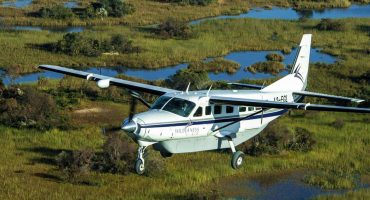 26 October 2017 by AfricanMecca Safaris, in Blog For AfricanMecca Safaris,Safari Planning Blog Posts - AfricanMecca Safaris
26 October 2017 by AfricanMecca Safaris, in Blog For AfricanMecca Safaris,Safari Planning Blog Posts - AfricanMecca Safaris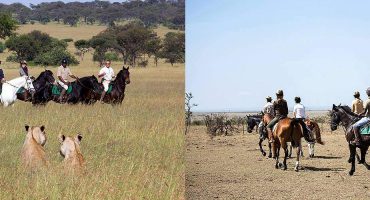 07 June 2017 by AfricanMecca Safaris, in Blog For AfricanMecca Safaris,Latest Kenya Blog Posts From AfricanMecca Safaris,Safari Planning Blog Posts - AfricanMecca Safaris
07 June 2017 by AfricanMecca Safaris, in Blog For AfricanMecca Safaris,Latest Kenya Blog Posts From AfricanMecca Safaris,Safari Planning Blog Posts - AfricanMecca Safaris






